Suivi et évaluation
La plupart des défis liés au suivi et à l’évaluation, comme la quantité insuffisante d’investissements et le manque de capacités, ne sont pas spécifiques à l’assistance monétaire, mais ceux qui le sont concernent principalement le suivi des résultats des transferts non affectés. La flexibilité des transferts monétaires peut compliquer la définition d’indicateurs de résultats appropriés, qui pourraient impliquer un mélange d’indicateurs spécifiques au secteur et transversaux. En parallèle, il existe des limitations au moment de collecter des données précises sur la manière dont les transferts monétaires sont dépensés.
Les signataires du Grand Bargain se sont engagés à garantir que des mécanismes de suivi et d’évaluation pertinents des transferts monétaires soient en place, et à assurer une meilleure compréhension des coûts, avantages, impacts et risques de cette modalité par rapport à d’autres. En partant de cet engagement, le chantier du Grand Bargain sur les transferts monétaires a établi plusieurs points d’action, dont le développement d’indicateurs de résultats communs pour les transferts monétaires à usages multiples, et des indicateurs pour l’analyse de l’optimisation des ressources. L’analyse systématique de l’optimisation des ressources a été rendue difficile par plusieurs facteurs, dont un manque d’approches approuvées, le besoin en données sur les résultats en termes de qualité et le caractère intensif de l’analyse.
Priorités actuelles
Dans le cadre des engagements du chantier du Grand Bargain sur les transferts monétaires, le CALP Network a co-dirigé (avec l’USAID et CRS) la mise au point d’indicateurs de résultats des transferts monétaires à usages multiples. Le projet à tester est actuellement disponible en anglais, espagnol et français, via la bibliothèque.
Initiatives associées
Contenu présenté

Indicateurs de résultats des transferts monétaires à usages multiples : Projet final à tester
Guides et outils
Les indicateurs présentés dans ce document se concentrent sur les principaux objectifs des TMUM humanitaires et sur les résultats auxquels les transferts monétaires à usages multiples peuvent le plus fortement contribuer. (Par exemple, certaines interventions en TMUM visent à relier les personnes aux systèmes de protection sociale après la fin du TMUM; mais nous n’avons pas inclus...

Monitoring 4 CTP: Monitoring Guidance for CTP in Emergencies
Guidelines and Tools
This guidance provides a central resource to promote a common understanding of the most important monitoring considerations for humanitarian projects using cash transfer programming (CTP). The primary audience for this guidance is field-level practitioners, from organisations directly involved in the design, implementation, monitoring, and accountability of projects using cash and vouchers...

Cost-Efficiency Analysis of Basic Needs Programs: Best Practice Guidance for Humanitarian Agencies
Guidelines and Tools
The Efficiency, Effectiveness and Value for Money Sub-Workstream is pleased to share the final output on Cost-Efficiency Analysis of Basic Needs Programs: Best Practice Guidance for Humanitarian Agencies (attached).
Cost-efficiency analysis estimates the ratio of program costs to outputs created, allowing you to compare cost-per-output for programs which all produced the same output. Such...
Thematic lead
Contenu récent

Rapid Assessment of Markets: World Vision Ecuador
Case Study
Information was collected in 7 cities which were selected because they have the highest Venezuelan population, and there are no other NGOs collecting similar information. Population surveyed corresponds to the Venezuelan population, complemented with interviews conducted in markets and houses where the...

Looking Back and Looking Forward: Somalia Drought Response: Cash and Voucher Assistance
Case Study
This report summarizes the discussions that took place during a one-day learning event on 11th June 2019. The event brought together 27 people from national and international NGOs, the UN, and donors to discuss progress, reflect on cash and voucher (CVA) assistance in Somalia and identify priorities for...

The Gendered Dimension of Multi-Purpose Cash Supporting Disaster Resilience
Report
In 2017, in response to the mounting humanitarian crisis in Yemen, CARE Yemen and Action Contra la Faim (ACF) implemented a cash transfer program and community asset rehabilitation and skill building programing in the governorates of Abyan and Amran. This European Union (EU)-funded program integrated...
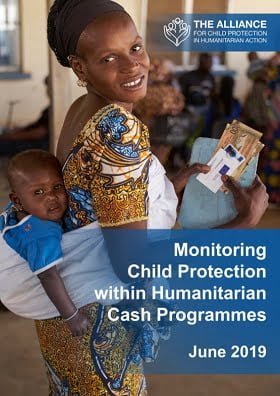
Monitoring Child Protection within Humanitarian Cash Programmes
Guidelines and Tools
This paper summarises findings from an initial scoping study, which seeks to review how child protection outcomes are captured when monitoring multi-purpose humanitarian cash programmes. The study intends to inform the development and piloting of new approaches to integrating child protection concerns...

Analyse des dynamiques sociales et des pouvoirs des parties prenantes pour la mise en place de Transferts Monétaires à Usage Multiple (TMUM) pluriannuels au Nord Mali
Rapport
Six ONG internationales (Action contre la Faim, Danish Refugee Council, Handicap International, International Rescue Committee, Oxfam et Solidarités International) ont mis en place un programme de transferts monétaires à usage multiple au Mali ; la deuxième phase de cette intervention de filets...

Impact Assessment for Cash for Education Project funded by DGECHO in Egypt
Report
The overall objectives of the Impact assessment were: To measure the impact of cash on the girls and boys by DGECHO funded project. To measure the impact of cash on Education and protection through a gender lens to investigate considerations of power dynamics in the households Understand the good...
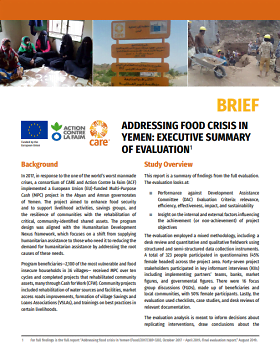
Addressing Food Crisis In Yemen: Executive Summary
Report
This report is a summary of findings from the full evaluation.
The evaluation looks at:
■ Performance against Development Assistance
Committee (DAC) Evaluation Criteria: relevance,
efficiency, effectiveness, impact, and sustainability
■ Insight on the internal and external factors influencing
the...

Le ciblage dans les systèmes de protection sociale : étude comparative sur deux méthodes
Rapport
Les filets sociaux sont en train de devenir un instrument clé des politiques visant une réduction de la pauvreté en Afrique sub-saharienne et constituent un élément de base des systèmes de protection sociale qui incluent la protection sociale adaptative. Les systèmes de protection sociale visent à...

Unblocked Cash Pilot Full Report
Report
This full report details the project scope, impact and learnings from the Unblocked Cash pilot in Vanuatu. The project was delivered in partnership with Oxfam Australia and ConsenSys, with funds from the Australian Government, and utilised a stablecoin, Dai, as the underlying value .

Cash for Work (CFW) Guidance Note
Guidelines and Tools
Cash for Work interventions provide employment to unskilled and semi-skilled workers on labour intensive projects such as rehabilitation of irrigation systems, soil conservation, and road construction and maintenance.

Are there gendered impacts to multi-purpose cash transfers intended to build resilience?
Report
Brief from full report “The Gendered Dimension of Multi-Purpose Cash Supporting Disaster Resilience” extracting the specific gendered findings from a study on the impact of an EU funded project that used a “Cash Plus” approach, combining ten monthly multi-purpose cash (MPC) transfers with the...

Global Cash Policy Network Call: the UN Common Cash System
Report
On 5 December, Principals of UNICEF, UNHCR, WFP and OCHA announced the launch of a joint system for the design, delivery and monitoring of cash assistance. This is a welcome step towards improved collaboration between United Nations agencies, with the potential to increase the effectiveness, efficiency...

Cash for Shelter in Kenya – A Field Experience
Report
A study of a cash for shelter project in Kalobeyei that highlights how UNHCR uses cash assistance to help the refugees to transition to more durable solutions, in this case, integration with the host community. The project presents a paradigm shift from the traditional refugee camp planning process.

It’s humanitarian planning season! Ten tips for strengthening the inclusion of cash assistance as part of the HRP process
Blog Post
It’s November and humanitarian planning season is in full swing. To its advocates, the Humanitarian Needs Overview (HNO) and Humanitarian Response Plan (HRP) process is a critical opportunity to collectively allocate resources and capacities to meet the most urgent humanitarian needs in a given context....
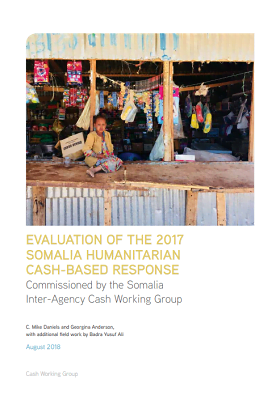
Evaluation of the 2017 Somalia Humanitarian Cash-Based Response
Report
After several years of poor rainfall, the humanitarian community responded to a famine alert issued in January 2017 with a significant scale-up of funding and programmes. Having originally published a 2017 Humanitarian Response Plan (HRP) in November 2016, by May 2017, the Somalia Humanitarian Country...
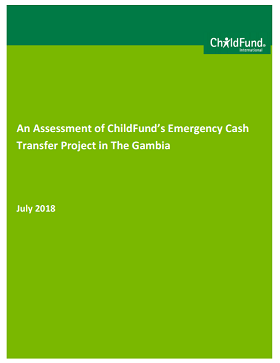
An Assessment of ChildFund’s Emergency Cash Transfer Project in The Gambia
Report
Review of ChildFund’s pilot cash transfer intervention using mobile money, assisting people displaced by political crisis. Includes description of project design, results, assessment, and recommendations for future cash-based interventions. Project participants appreciated the cash which they used to...
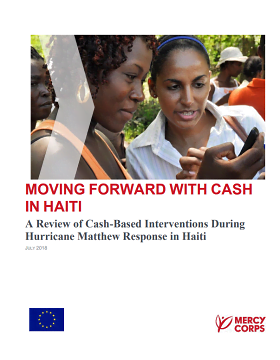
Moving Forward with Cash in Haiti: A Review of Cash-Based Interventions during Hurricane Matthew Response in Haiti
Case Study
Mercy Corps, with funding from European Civil Protection and Humanitarian Aid Operations (ECHO) has conducted an extensive review of lessons learned and contextual data, combined with key informant interviews and workshops to compile, analyse and present core lessons from the Hurricane Matthew cash-based...

The Grand Bargain Cash Meetings: what did we learn, how are we doing, where next?
Blog Post
After cash focal points from Grand Bargain signatory organisations gathered in Rome for the second annual meeting of the Grand Bargain cash workstream, we ask how much progress has been made towards commitments, and what remains to be done.

ERC Learning Event: Scaling up our tools and approaches for multi-purpose cash grants
Blog Post
Watch the videos and read the recommendations from the ERC MPG Consortium event in Addis Ababa, Ethiopia.
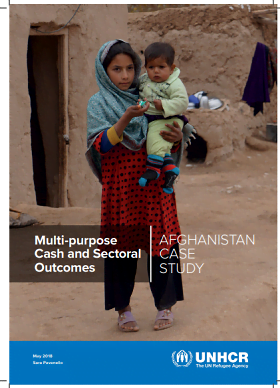
Multi purpose cash and sectoral outcomes – Afghanistan case study
Report
The repatriation cash grant has helped Afghan returnees from Pakistan to meet a number of basic needs upon return. The cash grant is used for transportation costs, to buy food and address important shelter needs, thus contributing to aspects of reintegration. At the same time, poor security of tenure and...
